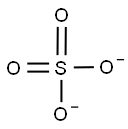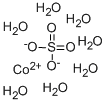Sulfate Standard , 500μg/mlinWater(20℃) , 14808-79-8
CAS NO.:14808-79-8
Empirical Formula: O4S-2
Molecular Weight: 96.06
MDL number: MFCD00145343
EINECS: 604-622-9
| Pack Size | Price | Stock | Quantity |
| 20ML | RMB31.20 | In Stock |
|
| 50ml | RMB55.20 | In Stock |
|
| others | Enquire |
PRODUCT Properties
| Density | 1.01g/cm3 at 20°C |
| storage temp. | 2-8°C |
| form | Liquid |
| color | Clear colorless |
| PH | 0.8 (20°C in H2O) |
| BRN | 3648446 |
| CAS DataBase Reference | 14808-79-8(CAS DataBase Reference) |
| EPA Substance Registry System | Sulfate (14808-79-8) |
Description and Uses
The sulfate anion (SO42−) is the stable, oxidized form of sulfur. Sulfate minerals are widely distributed in nature, and most sulfate compounds are readily soluble in water. All sulfate salts are very soluble except for calcium and silver sulfates, which are moderately soluble, and barium, mercury, lead, and strontium sulfates, which are insoluble.
It is estimated that about one-half of the river sulfate load arises from mineral weathering and volcanism, and the other half from biochemical and anthropogenic sources. Industrial discharges are another significant source of sulfates. Mine and tailings drainage, smelter emissions, agricultural runoff from fertilized lands, pulp and paper mills, textile mills, tanneries, sulfuric acid production, and metalworking industries are all sources of sulfate-polluted water. Aluminum sulfate (alum) is used as a sedimentation agent for treating drinking water. Copper sulfate is used for controlling algae in raw and public water supplies.




